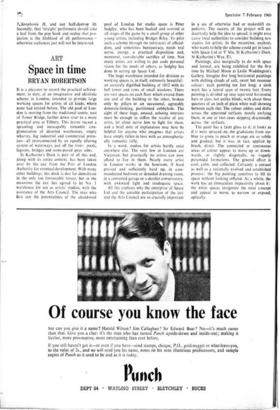Space in time
ART
BRYAN ROBERTSON
It is a pleasure to record the practical achieve- ment, to date, of an imaginative and idealistic scheme in London, intended to provide large working spaces for artists of all kinds, where none had existed before. The old pool of Lon- don is moving from the traditional centre, east of Tower Bridge, further down river to a more practical area at Tilbury. This leaves vacant a sprawling and inescapably romantic con- glomeration of deserted warehouses, empty wharves, big industrial and commercial prem- ises—all interconnected by an equally alluring system of waterways, just off the river: pools, lagoons, bridges and stone-paved quay sides.
St Katharine's Dock is part of all this and, along with its entire context, has been taken over by the Gi.c from the Port of London Authority for eventual development. With many other buildings, this dock is due for demolition in the only too foreseeable future, but in the meantime the ct..c has agreed to let No. 1 - warehouse for use as artists' studios, with the assistance of the Arts Council. The man who first saw the potentialities of the abandoned pool of London for studio space is Peter Sedgley, who has been backed and assisted at all stages of the game by a small group of other young artists, including Bridget Riley. To pilot such a scheme through the intricacies of official- dom, and sometimes bureaucracy, needs real nerve, energy, a practical disposition and, moreover, considerable sacrifice of time. Not many artists are willing to put aside personal vision for the needs of others, as Sedgley has done in setting up Space Ltd.
The huge warehouse intended for division as working spaces is, in itself, extremely beautiful: an austerely dignified building of 1812 with its bell tower and rows of small windows. There are vast spaces on each floor which extend from one end of the building to the other, broken only by pillars or an occasional, agreeably domestic-looking, partitioned cubbyhole. The sight of these huge, unused, echoing interiors must be enough to stiffen the resolve of any artist, let alone nerve him to fight for them, and a brief note of explanation may here be helpful for anyone who imagines that artists have simply fallen in love with an atmospheric- ally romantic folly.
In a word, studios for artists hardly exist anywhere else. The very few in London are Victorian, but practically no artists can now afford to live in them. Nearly every artist in London works in the boxroom, if hard pressed and sufficiently hard up, in com- mandeered bedroom or denuded drawing room, in a converted garage or a derelict conservatory, with awkward light and inadequate space.
All this explains why the enterprise of Space Ltd and the amiable participation of the GLC and the Arts Council are so crucially important
in a sea of otherwise bad or makeshift ex- pedients. The success of the project will un- doubtedly help the idea to spread; it might even cause local authorities to consider building new studios for artists. In the meantime, anybody who wants to help the scheme could get in touch with Space Ltd at 'I' Site, St Katharine's Dock, St Katharine's Way, El.
Paintings, also marginally to do with space and format, are being exhibited for the first time by Michael Moon at Leslie Waddington's Gallery. Imagine five long horizontal paintings with shifting clouds of soft, sweet but resonant colour : each painting ten feet long; a sixth work has a lateral span of twenty feet. Every painting is divided up into separated horizontal bars or slats, not unlike blinds, with about three quarters of an inch of plain white wall showing between each slat. The colour eddies and drifts across the separated surfaces, mostly unifying them, in one or two cases skipping disjointedly across the surfaces.
The paint has a faint gloss to it: it looks as if it were sprayed on, the gradations from ice- blue to green to peach or orange are so subtle and gradual, but it was, in fact, applied by brush, direct. The connected or continuous areas of colour appear to move up or down- wards, or slightly diagonally, in vaguely pyramidal formations. The general effect is cool, calm, and collected. Certainly a sensual as well as a rationally evolved and established process: the big painting contrives to fill its space without looking inflated. As a whole, the work has an immaculate impassivity about it: the white spaces invigorate the total concept and appear to move, to narrow or expand, optically.






































 Previous page
Previous page